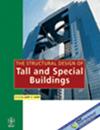Rubber effect on metallic dampers used on the supports of steel cross members
IF 1.3
3区 工程技术
Q3 CONSTRUCTION & BUILDING TECHNOLOGY
引用次数: 0
Abstract
There are many strengthening methods made with steel cross members for strengthening the structures with inadequate earthquake behavior. This type of strengthening methods is also effective in buckling of the cross members in the behavior of the structural frames. This buckling may cause partial or complete collapse of the structure. Thus, it is quite important to prevent and limit the formation of buckling in steel crosses. At the TEC 2018, the insulation unit is defined as the elements that can exhibit flexible behavior on the horizontal direction and rigid behavior on the vertical direction under the effect of earthquake loads. The basic principle of using insulation units is that these members can dissipate energy in the carrier system. The originality of this study is to experimentally investigate the damper behavior created by using cylindrical rubber wedges, which can be easily found in the automotive industry, in combination with steel plates and bolts. In this experimental study, the contribution of seismic insulators to the structural element to be strengthened was investigated. The insulators used in this study are considered by analogy with lead‐core rubber insulators. As such seismic lead‐core rubber insulators move under the influence of lateral loads, the lead core inside makes plastic deformation, thus increasing the damping rate. In this insulator study, it is aimed to use U plates or bolts instead of lead core. While vertical loads are covered by rubber support, horizontal loads will be damped due to plastic deformation of U plates or bolts. The five types of seismic dampers were used as 10 B‐type rubber wedge mounted damper (SR), 2 U‐type steel plates damper (SP), 10 M6 steel bolted damper (SB), 2 U‐type steel plates and 10 B‐type rubber wedge mounted damper (SPR), 10 M6 steel bolted, and 10 C‐type rubber wedge mounted damper (SBR). These specimens were tested under lateral loading and constant vertical loading. The results obtained at the end of the tests shall be compared considering the strength, stiffness, and dissipated energy capacities of the specimens.橡胶对用于钢横梁支架的金属阻尼器的影响
针对地震性能不佳的结构,有许多采用钢交叉构件的加固方法。这种加固方法对框架结构中交叉构件的屈曲也是有效的。这种屈曲可能导致结构的部分或全部坍塌。因此,防止和限制钢十字板屈曲的形成是十分重要的。在TEC 2018中,保温单元被定义为在地震荷载作用下,在水平方向上表现出柔性行为,在垂直方向上表现出刚性行为的元件。使用绝缘单元的基本原理是这些构件可以耗散载波系统中的能量。本研究的独创性在于通过实验研究使用圆柱形橡胶楔(在汽车工业中很容易找到)与钢板和螺栓相结合所产生的阻尼器行为。在本试验研究中,研究了隔震层对待加固结构单元的贡献。本研究中使用的绝缘子与铅芯橡胶绝缘子类似。在侧向荷载作用下,导芯橡胶绝缘子内部的导芯发生塑性变形,从而增加了阻尼率。在本绝缘子研究中,目的是使用U型板或螺栓代替铅芯。当垂直荷载被橡胶支撑覆盖时,水平荷载会因U型板或螺栓的塑性变形而受到阻尼。这五种类型的减震器分别是:10个B型橡胶楔式减震器(SR)、2个U型钢板减震器(SP)、10个M6钢螺栓减震器(SB)、2个U型钢板和10个B型橡胶楔式减震器(SPR)、10个M6钢螺栓减震器和10个C型橡胶楔式减震器(SBR)。这些试件在侧向荷载和恒定垂直荷载下进行了试验。试验结束时获得的结果应考虑试件的强度、刚度和耗散能量进行比较。
本文章由计算机程序翻译,如有差异,请以英文原文为准。
求助全文
约1分钟内获得全文
求助全文
来源期刊
CiteScore
5.30
自引率
4.20%
发文量
83
审稿时长
6-12 weeks
期刊介绍:
The Structural Design of Tall and Special Buildings provides structural engineers and contractors with a detailed written presentation of innovative structural engineering and construction practices for tall and special buildings. It also presents applied research on new materials or analysis methods that can directly benefit structural engineers involved in the design of tall and special buildings. The editor''s policy is to maintain a reasonable balance between papers from design engineers and from research workers so that the Journal will be useful to both groups. The problems in this field and their solutions are international in character and require a knowledge of several traditional disciplines and the Journal will reflect this.
The main subject of the Journal is the structural design and construction of tall and special buildings. The basic definition of a tall building, in the context of the Journal audience, is a structure that is equal to or greater than 50 meters (165 feet) in height, or 14 stories or greater. A special building is one with unique architectural or structural characteristics.
However, manuscripts dealing with chimneys, water towers, silos, cooling towers, and pools will generally not be considered for review. The journal will present papers on new innovative structural systems, materials and methods of analysis.

 求助内容:
求助内容: 应助结果提醒方式:
应助结果提醒方式:


